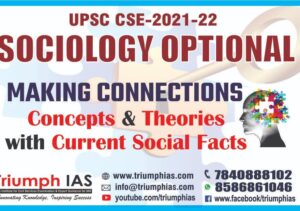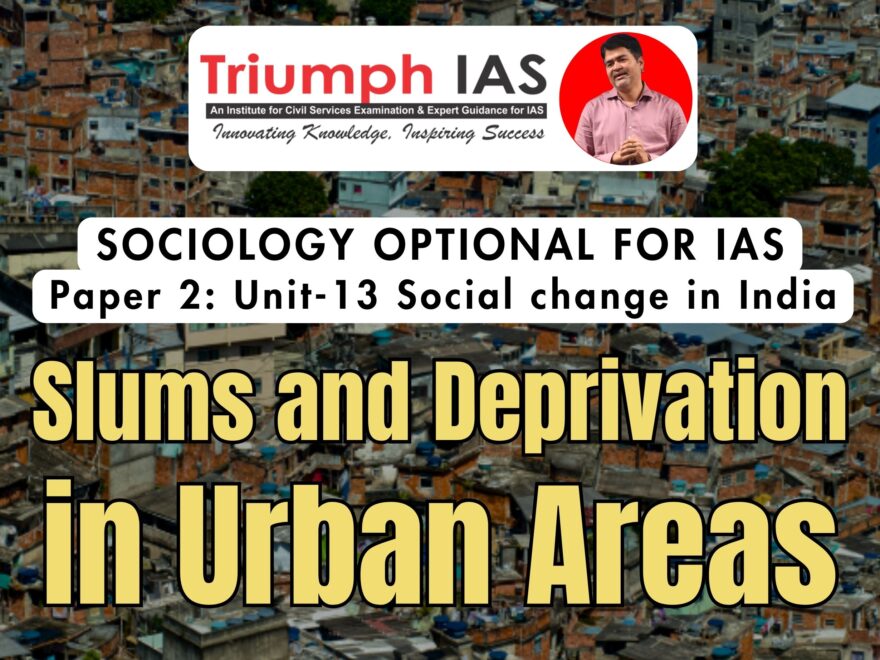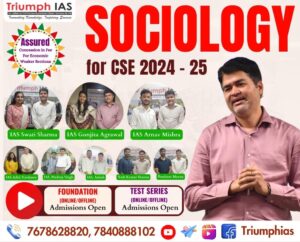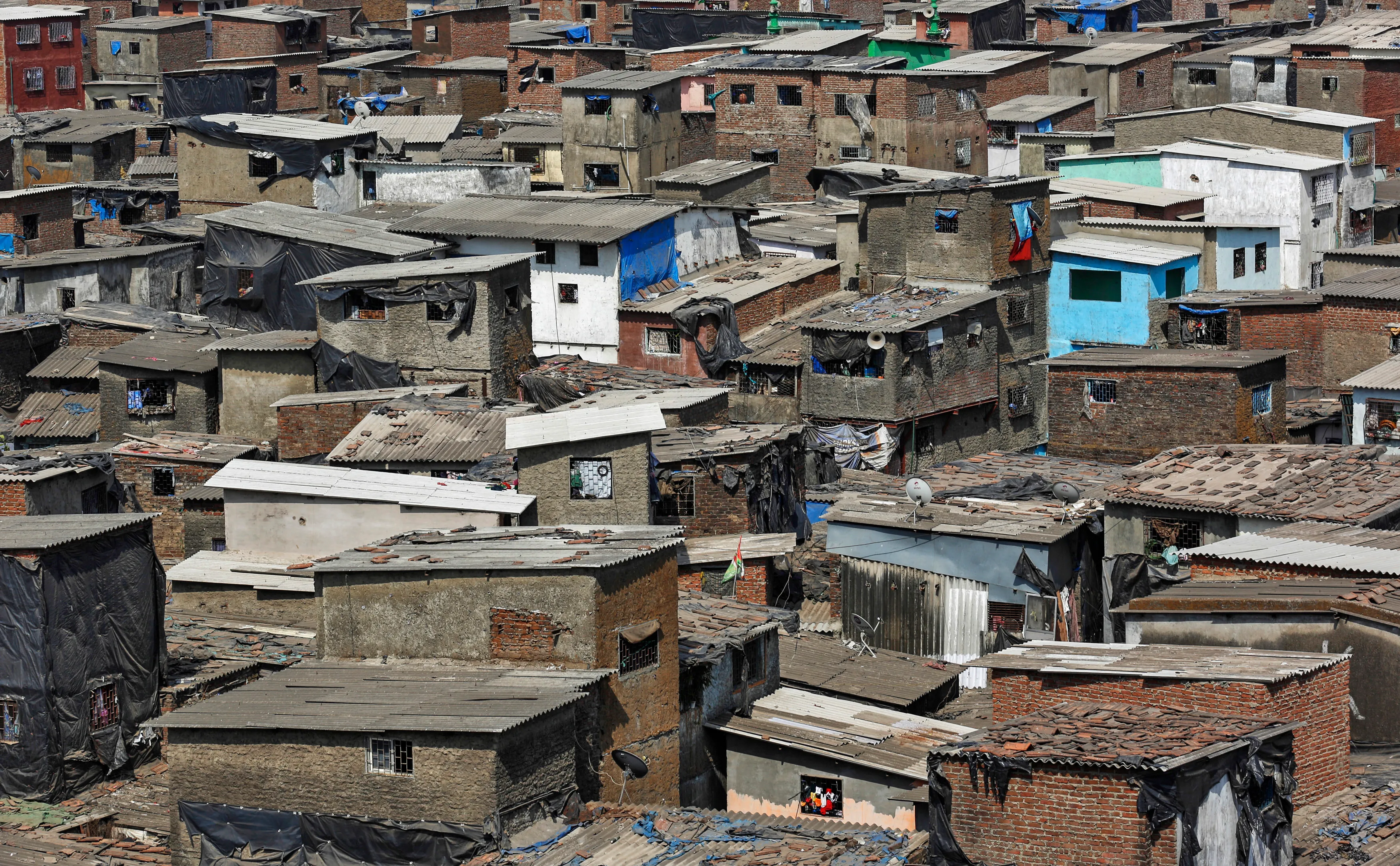Slums and Deprivation in Urban Areas
Relevant for Sociology Optional for Civil Service Examination.
Paper 2: Unit-13 Social change in India; Slums and Deprivation in Urban Areas
Slums and Deprivation in Urban Areas
|
The concept of slums encompasses areas where the buildings are unsuitable for human habitation due to dilapidation, overcrowding, poor design, narrow streets, lack of ventilation, light, or sanitary facilities, posing risks to safety, health, and morality according to the Slum Area Improvement and Clearance Act 1956. The proliferation of slums is viewed as a significant societal challenge, akin to the population explosion, and is associated with substandard urban housing, with percentages of slum populations in major cities like Bombay, Calcutta, Madras, and Delhi ranging from 31.40% to 34.30%. The genesis of slums is attributed to the influx of impoverished individuals from rural areas drawn to urban economic opportunities, leading to the establishment of slums and squatter settlements. These urban poor communities provide essential services such as vending, plumbing, waste disposal, and domestic services to the city population. Despite efforts to control this process through legal and regulatory means, economic factors and consumer demand perpetuate the cycle, driving the urban poor to occupy open lands and establish slums in optimal locations. Moreover, the cost of housing schemes designed for the economically disadvantaged often exceeds the means of slum dwellers, further exacerbating the housing shortage. The types of slums include original slums, transitional zone slums, and deteriorated areas near business districts populated by individuals facing social and physical decay. To address these challenges, initiatives such as the Environmental Improvement of Urban Slums (EIUS), soft loans for slum upgrades, and shelter upgradation schemes have been implemented by the government. Additionally, the Jawaharlal Nehru Urban Renewal Mission (JNURM) and Valmiki Ambedkar Aawas Yojana (VAMBAY) have been introduced to provide housing and basic services for the urban poor, emphasizing the need for a multi-faceted approach to combat the widespread issue of slums in developing countries. |
Introduction
Slums are a pervasive issue in many developing countries, characterized by substandard living conditions that pose risks to safety, health, and morality. The formation of slums is often driven by the influx of impoverished individuals from rural areas seeking economic opportunities in urban centers. Despite various efforts to control this process, economic factors and consumer demand often perpetuate the establishment of slums in prime urban locations.
Types of Slums
Different types of slums exist, each with its own unique characteristics. Original slums are typically the result of spontaneous and unauthorized settlements on vacant or public lands. Transitional zone slums emerge in areas undergoing rapid urbanization, often lacking adequate infrastructure and basic services. Deteriorated areas near business districts also serve as locations for slums, as impoverished individuals seek employment opportunities in these urban centers.
Challenges Faced by Slum Dwellers
Slum dwellers face numerous challenges, including inadequate housing, lack of access to clean water and sanitation, limited educational and employment opportunities, and exposure to crime and violence. The cost of formal housing schemes designed for the economically disadvantaged often exceeds the means of slum dwellers, further exacerbating their living conditions.
Initiatives to Address Slums
Several initiatives have been implemented to address the challenges associated with slums. The Environmental Improvement of Urban Slums (EIUS) focuses on enhancing the living conditions within slum areas by improving infrastructure and providing basic services. Additionally, soft loans for slum upgrades and shelter upgradation schemes have been introduced to improve the housing conditions of slum dwellers.
Government Initiatives
Governments in developing countries have also introduced programs to tackle the issue of slums. The Jawaharlal Nehru Urban Renewal Mission (JNURM) in India aims to provide basic services and housing for the urban poor, while the Valmiki Ambedkar Aawas Yojana (VAMBAY) focuses on the construction of houses for slum dwellers.
The Need for a Multi-Faceted Approach
Addressing the widespread issue of slums requires a multi-faceted approach. This approach should encompass urban planning and development, affordable housing initiatives, infrastructure improvement, access to basic services, and economic empowerment programs for slum dwellers. Collaboration between government bodies, non-governmental organizations, and the private sector is essential to effectively combat the challenges associated with slums.
Conclusion
The issue of slums in developing countries is complex and multifaceted, requiring a holistic approach to address the various challenges faced by slum dwellers. By implementing initiatives that focus on improving living conditions, providing affordable housing, and enhancing economic opportunities, it is possible to make meaningful strides towards alleviating the hardships endured by those living in slums. With concerted efforts and collaborative strategies, the goal of creating sustainable and inclusive urban environments can be achieved.
Reference: Static Portion
Related Blogs…
 |
 |
Frequently Asked Questions:
1. Question: Define the term “ethnic movement” and provide an example from India.
Answer: An ethnic movement refers to a collective effort by a group sharing common cultural, linguistic, or religious traits, seeking to assert their identity and rights; an example from India is the Khalistan Movement in Punjab.
2. Question: Identify the main objectives behind the Gorkhaland ethnic movement.
Answer: The Gorkhaland ethnic movement primarily seeks to establish a separate state for India’s Nepali-speaking population in the Darjeeling region, advocating for linguistic and cultural recognition and political autonomy.
3. Question: What was the Operation Blue Star, and which ethnic movement was it related to?
Answer: Operation Blue Star was a military action in 1984, aiming to remove Sikh militants hiding in the Golden Temple in Amritsar; it is related to the Khalistan movement, which sought a separate Sikh country.
4. Question: Mention a critical factor that triggered the emergence of ethnic movements in India, as discussed by Dipankar Gupta.
Answer: Dipankar Gupta emphasized that ethnicity is fundamentally a political process, wherein caste and religion, the key components of identity formation, are politicized by leaders for vested interests.
5. Question: What were the primary reasons for the Assam Ethnicity conflicts involving Bodo tribals and Bengali Muslim settlers?
Answer: The Assam Ethnicity conflicts primarily stemmed from issues related to immigration, land rights, and resource allocation, leading to clashes, riots, and evolving relationships among indigenous communities to address challenges.
6. Question: Briefly describe the role of the Dravidian Movement in terms of caste and societal structure.
Answer: The Dravidian Movement, led notably by E.V. Ramasamy, aimed to establish an egalitarian society, focusing on anti-Brahmanism and advocating for equal rights for backward castes, while also introducing reforms like self-respect marriages.
7. Question: Name the prominent ethnic movements in North-East India and specify one common objective.
Answer: Prominent ethnic movements in North-East India include the Nagas’ and Mizos’ struggles; a common objective was to gain autonomy and recognition for their distinct tribal identities and cultural uniqueness.
8. Question: What is the key argument of Gail Omveldt regarding traditional Indian society and multiculturalism?
Answer: Gail Omveldt opposed romanticizing traditional Indian society, arguing that hierarchy has always dominated it and dismissing the notion that multiculturalism is an intrinsic feature of Indian society as a myth.
9. Question: Briefly explain the social hierarchy factor as a contributing element to ethnic movements as suggested by Olzak.
Answer: Olzak suggests that the construction of hierarchies among ethnic communities, which often leads to the suppression of one group by another, is a key factor that can instigate social and ethnic movements.
10. Question: Identify one consequence of the unequal economic development factor within the context of ethnic movements in India.
Answer: One consequence of unequal economic development is the marginalization and underdevelopment of certain groups, leading to feelings of alienation and sometimes initiating ethnic movements as these groups strive for equality and recognition.
GS Related Practices Questions…
To master these intricacies and fare well in the Sociology Optional Syllabus, aspiring sociologists might benefit from guidance by the Best Sociology Optional Teacher and participation in the Best Sociology Optional Coaching. These avenues provide comprehensive assistance, ensuring a solid understanding of sociology’s diverse methodologies and techniques.
META TAGS:
Ethnic Movements, ethnic movements in india, ethnic movement in sociology, Punjab Movement, North-East Ethnic Movements, Gorkhaland Movement, Dravidian Movement, Assam Ethnicity, Ethnic Conflicts, Sociopolitical Impact, India, Ethnic Consciousness, Ethnic Rights, Political Crisis, Economic Development, Cultural Disparities, Khalistan Movement, Nagaland, Mizoram, Multiculturalism, Political Economy, Identity Formation, Social Hierarchies, Bodo Tribals, Bengali Muslim Settlers, Anti-Sikh Riots, Operation Blue Star, Unequal Development, Ethnic Violence, Political Mobilization

Why Vikash Ranjan’s Classes for Sociology?
Proper guidance and assistance are required to learn the skill of interlinking current happenings with the conventional topics. VIKASH RANJAN SIR at TRIUMPH IAS guides students according to the Recent Trends of UPSC, making him the Best Sociology Teacher for Sociology Optional UPSC.
At Triumph IAS, the Best Sociology Optional Coaching platform, we not only provide the best study material and applied classes for Sociology for IAS but also conduct regular assignments and class tests to assess candidates’ writing skills and understanding of the subject.
Choose The Best Sociology Optional Teacher for IAS Preparation?
At the beginning of the journey for Civil Services Examination preparation, many students face a pivotal decision – selecting their optional subject. Questions such as “which optional subject is the best?” and “which optional subject is the most scoring?” frequently come to mind. Choosing the right optional subject, like choosing the best sociology optional teacher, is a subjective yet vital step that requires a thoughtful decision based on facts. A misstep in this crucial decision can indeed prove disastrous.
Ever since the exam pattern was revamped in 2013, the UPSC has eliminated the need for a second optional subject. Now, candidates have to choose only one optional subject for the UPSC Mains, which has two papers of 250 marks each. One of the compelling choices for many has been the sociology optional. However, it’s strongly advised to decide on your optional subject for mains well ahead of time to get sufficient time to complete the syllabus. After all, most students score similarly in General Studies Papers; it’s the score in the optional subject & essay that contributes significantly to the final selection.
“A sound strategy does not rely solely on the popular
Opinion of toppers or famous YouTubers cum teachers.”
It requires understanding one’s ability, interest, and the relevance of the subject, not just for the exam but also for life in general. Hence, when selecting the best sociology teacher, one must consider the usefulness of sociology optional coaching in General Studies, Essay, and Personality Test.
The choice of the optional subject should be based on objective criteria, such as the nature, scope, and size of the syllabus, uniformity and stability in the question pattern, relevance of the syllabic content in daily life in society, and the availability of study material and guidance. For example, choosing the best sociology optional coaching can ensure access to top-quality study materials and experienced teachers. Always remember, the approach of the UPSC optional subject differs from your academic studies of subjects. Therefore, before settling for sociology optional, you need to analyze the syllabus, previous years’ pattern, subject requirements (be it ideal, visionary, numerical, conceptual theoretical), and your comfort level with the subject.
This decision marks a critical point in your UPSC – CSE journey, potentially determining your success in a career in IAS/Civil Services. Therefore, it’s crucial to choose wisely, whether it’s the optional subject or the best sociology optional teacher. Always base your decision on accurate facts, and never let your emotional biases guide your choices. After all, the search for the best sociology optional coaching is about finding the perfect fit for your unique academic needs and aspirations.
To master these intricacies and fare well in the Sociology Optional Syllabus, aspiring sociologists might benefit from guidance by the Best Sociology Optional Teacher and participation in the Best Sociology Optional Coaching. These avenues provide comprehensive assistance, ensuring a solid understanding of sociology’s diverse methodologies and techniques. Sociology, Social theory, Best Sociology Optional Teacher, Best Sociology Optional Coaching, Sociology Optional Syllabus.
Best Sociology Optional Teacher, Sociology Syllabus, Sociology Optional, Sociology Optional Coaching, Best Sociology Optional Coaching, Best Sociology Teacher, Sociology Course, Sociology Teacher, Sociology Foundation, Sociology Foundation Course, Sociology Optional UPSC, Sociology for IAS,
Follow us :
🔎 https://www.instagram.com/triumphias
🔎https://www.youtube.com/c/TriumphIAS
🔎https://t.me/VikashRanjanSociology
Find More Blogs…
| Compare and contrast Karl Marx’s and Max weber’s | Karl Marx- Historical Materialism |
| Talcott Parsons : Social system | Scope of the subject and comparison with other social sciences |
KEYWORD: -*Slums and Deprivation in Urban Areas, Applied sociology, upsc sociology, vikash ranjan sociology, sociology classes online, upsc sociology classes online, vikash sir sociology, sociology triumph ias, triumph ias sociology,





